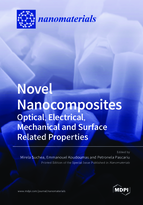Novel Nanocomposites: Optical, Electrical, Mechanical and Surface Related Properties
A special issue of Nanomaterials (ISSN 2079-4991). This special issue belongs to the section "Nanocomposite Materials".
Deadline for manuscript submissions: closed (31 July 2021) | Viewed by 21524
Special Issue Editors
2. Center of Materials Technology and Photonics, Hellenic Mediterranean University, 71004 Heraklion, Crete, Greece
Interests: nanotechnology; materials engineering and applications: photocatalytic materials; materials for envinronmental and clean energy applications; composite materials for electromagnetic shielding; transparent electrode materials development including graphene (synthesis, deposition and functionalization); colloidal synthesis of metal nanoparticles; surface modification of metal oxide; graphene oxide and reduced graphene oxide films using metal nanoparticles for plasmonic effects on optical properties and silicon rubber based composite insulators for high voltage applications
Special Issues, Collections and Topics in MDPI journals
2. Center of Materials Technology and Photonics, Hellenic Mediterranean University, 71004 Heraklion, Crete, Greece
Interests: nanomaterials; polymer nanocomposites; electrochromic layers; thermochromic layers; metal oxides; carbon allotropes; electromagnetic shielding; transparent electrodes; photocatalysis
Special Issues, Collections and Topics in MDPI journals
2. National Institute for R&D in Microtechnologies - IMT Bucharest 126A Erou Iancu Nicolae St., 077190 Bucharest, Romania
3. Center of Materials Technology and Photonics, Hellenic Mediterranean University, 71004 Heraklion, Crete, Greece
Interests: design; synthesis and investigation of nanoparticles; thin films and multilayers nanowires; metal oxide ceramic nanofibers based on ZnO and TiO2 doped with Ni, Co, Ag, La, Er, Sm, Mo, etc. composites; polymer/inorganic nanoparticles nanostructures, with specific optical; electrical; photocatalytic and magnetic properties for use in various modern applications (photocatalysis, sensors, electronics and optoelectronics, electrochemical supercapacitors, etc.), which are obtained by electrochemical and electrospinning method, respectively
Special Issues, Collections and Topics in MDPI journals
Special Issue Information
Dear Colleagues,
The development of novel nanocomposite materials with enhanced physical and chemical properties is one of the emergent topics of the recent years. Since the development of affordable available commercially nanomaterials, nanocomposites have become a most desirable product. Development of novel nanocomposites with enhanced optical properties became of real interest for domains such as data transmission, sensors, nonlinear optics devices, etc. Electric/dielectric nanocomposites are on the top of the research for novel supercapacitors or other renewable energy applications; nanocomposites with specific surface properties became very attractive for antistatic, antibacterial, photocatalytic, etc., functional surface applications while enhanced mechanical properties are desirable for a plethora of needs in transportation, home appliances, architectural applications, etc. Having simultaneously more than one functionality is possible using nanocomposites materials by achieving a synergistic effect of nano-components/matrix properties. The present Special Issue aims to cover a broad range of subjects, from nanocomposites synthesis/fabrication to the design and characterization of various nanocomposites materials with enhanced optical, electrical, mechanical, and surface-related properties as well as practical applications. The format of welcome articles includes original full papers, communications, and reviews.
Potential topics include, but are not limited to:
- Nanocomposite materials with enhanced optical properties
- Nanocomposite materials with enhanced electrical properties
- Nanocomposite materials with enhanced surface related properties
- Nanocomposite materials with enhanced mechanical properties
Dr. Mirela Suchea
Dr. Petronela Pascariu
Prof. Dr. Emmanouel Koudoumas
Guest Editor
Manuscript Submission Information
Manuscripts should be submitted online at www.mdpi.com by registering and logging in to this website. Once you are registered, click here to go to the submission form. Manuscripts can be submitted until the deadline. All submissions that pass pre-check are peer-reviewed. Accepted papers will be published continuously in the journal (as soon as accepted) and will be listed together on the special issue website. Research articles, review articles as well as short communications are invited. For planned papers, a title and short abstract (about 100 words) can be sent to the Editorial Office for announcement on this website.
Submitted manuscripts should not have been published previously, nor be under consideration for publication elsewhere (except conference proceedings papers). All manuscripts are thoroughly refereed through a single-blind peer-review process. A guide for authors and other relevant information for submission of manuscripts is available on the Instructions for Authors page. Nanomaterials is an international peer-reviewed open access semimonthly journal published by MDPI.
Please visit the Instructions for Authors page before submitting a manuscript. The Article Processing Charge (APC) for publication in this open access journal is 2900 CHF (Swiss Francs). Submitted papers should be well formatted and use good English. Authors may use MDPI's English editing service prior to publication or during author revisions.
Keywords
- nanocomposites materials
- advanced applications
- optical properties
- electrical properties
- mechanical properties
- surface-related properties
- photocatalytic









